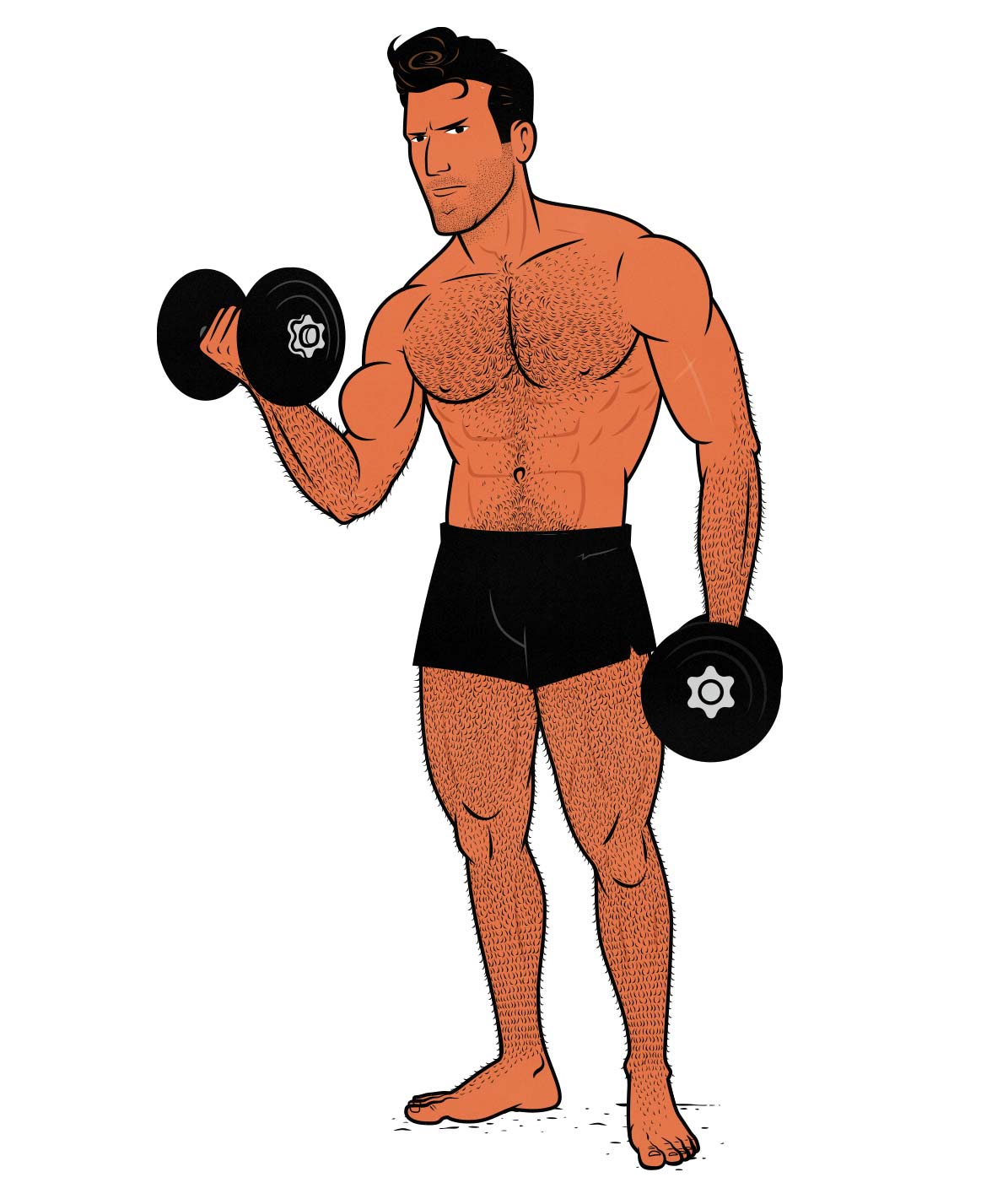
Maintenance Training Volume: How Many Sets to Maintain Muscle?
The other day, I wrote an article about Reverse Bulking, my favourite method for maintaining gains after bulking. The idea is to keep lifting weights, keep eating a good diet, and keep living a healthy lifestyle, but to start listening to your appetite again. Most naturally thin guys tend to eat less, lose weight, and reclaim any leanness lost while bulking—while maintaining their gains.
The idea of Reverse Bulking brings up a couple of questions. Perhaps the most important of those is how hard we should train to maintain our muscle size and strength. More specifically, how many hard sets do we need per muscle group?

The Minimum Training Volume to Maintain Muscle
Think about this from your body’s perspective: it just finished investing all this energy into building bigger and stronger muscles. It won’t undo those costly adaptations unless there’s some advantage to doing so.
However, it takes energy to maintain your muscle mass. Every pound of muscle burns around 6 calories per day, plus whatever energy you use to lug it around. So, if you aren’t using your muscles at all, ever, then your body may as well lower its expenses by getting rid of them. This is why we see tremendous rates of muscle loss in bedridden people, slow rates of muscle loss in active people, and no muscle loss whatsoever in people who continue lifting weights.
To maintain muscle mass, you must remind your body you need your muscles.
In a study by Bickel and colleagues, the participants followed a muscle-building workout routine for 16 weeks, then went into a low-volume maintenance phase for 32 weeks (study). During those 32 weeks of doing just a couple of sets per muscle per week, the participants gained a little bit of strength.

The drop in training volume was fairly extreme, too. The young and middle-aged participants cut their volume down to just 1/9th of what they were doing before. The older lifters (60–75 years old) maintained their strength with 1/3 of their original training volume.
In practical terms, you can probably maximize your rate of muscle growth with something like 9–18 sets per muscle group per week, provided you choose good exercises, rest long enough between sets, and push yourself hard. When you switch over to maintenance, you could cut that down to more like 2–5 sets per muscle group per week. That might not sound like much, but it might even be enough for you to continue building muscle.
How to Count Training Volume
A good rule of thumb is to count every hard set as one unit of “volume” (full explanation). So if you do 5 sets of bench presses and 5 sets of push-ups every week to bulk up your chest, that’s a training volume of 10. You could cut that down to just 2–5 sets of push-ups and expect to maintain your gains.
That raises some questions. For instance, do those push-ups count as volume for secondary muscle groups, such as your triceps? If you were trying to maximize your rate of muscle growth, I’d say no. Pressing movements aren’t great for your triceps. You’d want some triceps extensions in your routine.
However, compound lifts are more than enough to maintain your gains, even in secondary muscle groups. For example, in a study by Brandão and colleagues, triceps extensions yielded twice as much triceps growth as the bench press (study). However, the bench press still caused the triceps to grow. So we’re okay.
How to Adjust Training Volume While Losing Weight
When you’re feeding your body enough energy, it has little need to dip into your muscle mass for more. If you’re in an aggressive calorie deficit, the situation changes. Your body has every reason to get energy from wherever it can, including from your muscles. That’s why when you’re cutting, you need to be more careful about how you eat and train.
In seeming contradiction to what I just said, a study by Roth and colleagues compared high-volume cutting routines against moderate-volume ones, finding no difference in results (study). Both routines did a great job of maintaining muscle mass. However, even the low-volume lifters did far more than 2 sets per muscle group per week. They were doing more like 10 sets per muscle per week.
- Reverse Bulking: if you’re reverse bulking, casually losing weight, low training volumes can be enough. You don’t need to raise your training volume to account for the weight loss.
- Cutting: if you’re cutting, quickly losing weight, or trying to get to an impressively lean body-fat percentage, it might pay to train with a higher volume. Maybe instead of dropping to 2–5 sets per muscle group per week, you do more like 5–10 sets.
Maintaining General Health
It doesn’t take much resistance training to meet general health requirements. Most research shows you can keep your body working well with as few as two workouts per week (study, Harvard). That will keep your muscles strong, your bones dense, and your tendons tough. It’s also enough to maintain your mobility and coordination.
However, the minimum requirements for exercise are quite a bit higher. If you’re cutting back on resistance training, you may need to go on more walks or do more cardio to hit the minimum physical activity requirements.
Conclusion
You only need a few sets per muscle group per week to maintain your muscle size and strength. The easiest way to get that volume in is to do the big compound lifts once or twice per week. For example, you could squat, deadlift, press, and pull every Monday and Thursday, doing 2–4 sets per exercise per workout. Bring each of those sets within 0–3 reps of failure. I tend to push it closer to failure.
These are the minimum volume recommendations. Feel free to do more. You can keep doing your favourite isolation lifts, keep trying to bring up lagging muscle groups, or work on getting stronger. Less is enough, but more can be better.
Fight to maintain at least 90% of your strength on the big compound lifts. If you start suffering from progressive underload, add some extra sets in. If you’re maintaining your strength, you’re doing great. If you’re gaining strength, you’ve grasped the holy grail, building muscle while losing fat.

Alright, that’s it for now. If you want to know all the ins and outs of building muscle, we have a free newsletter. If you want a full foundational bulking program, including a 5-month full-body workout routine, gain-easy diet guide, recipe book, and online coaching, check out our Bony to Beastly Bulking Program. Or, if you want a customizable intermediate bulking program, check out our Outlift Program.
Shane Duquette is the founder of Outlift, Bony to Beastly, and Bony to Bombshell, each with millions of readers. He's a Certified Conditioning Coach (CCC), has gained 70 pounds, and has over a decade of experience helping more than 15,000 people build muscle. He also has a degree in fine arts, but those are inversely correlated with muscle growth.

Muscle-Building Mini-Course via EMAIL
Sign up for our 5-part muscle-building mini-course that covers everything you need to know about:
Here are some related articles